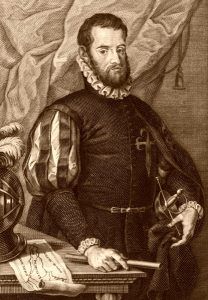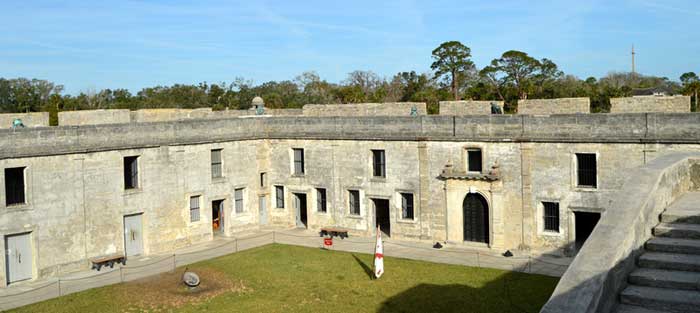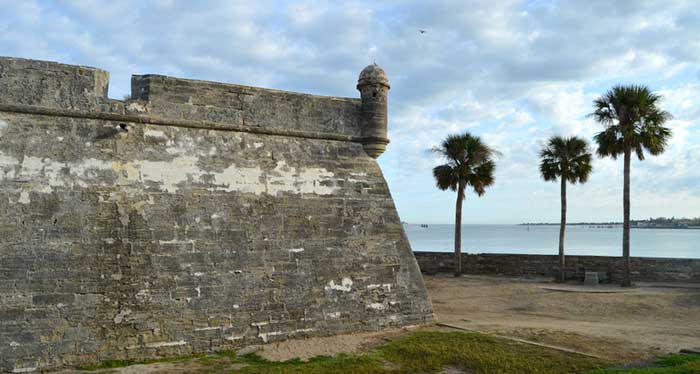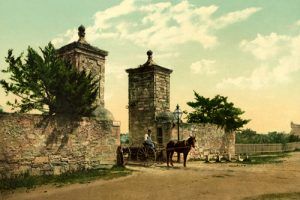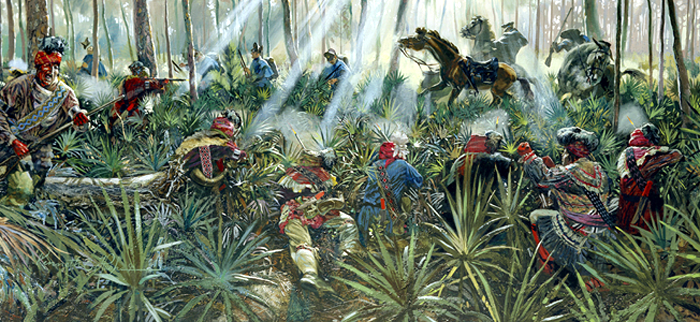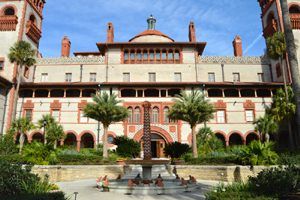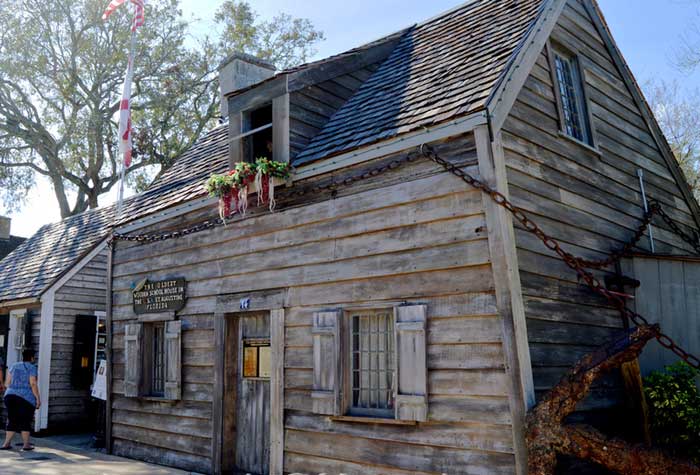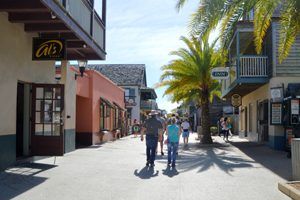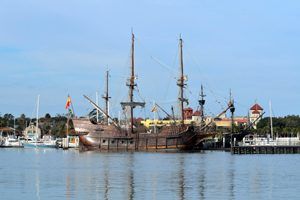Located in Northeast Florida, St. Augustine is the oldest continuously occupied European-established settlement and port in the continental United States. The area was first explored by Spanish Puerto Rico Governor Juan Ponce de Leon on April 3, 1513, when he landed, remained for five days, and claimed the region for the Spanish Crown.
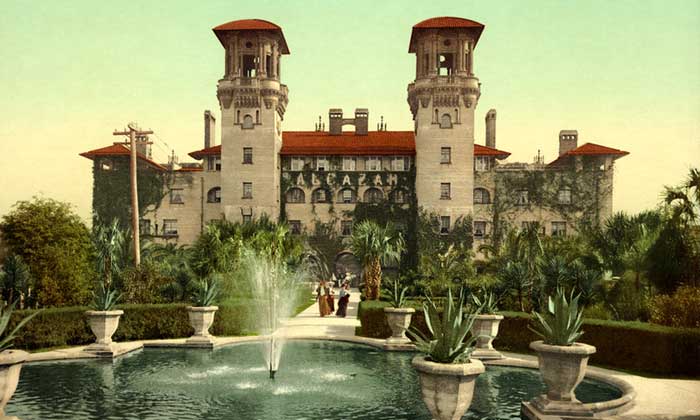
The Alcazar Hotel is now the Lightner Museum in St. Augustine, Florida. Photo by Detroit Photographic Co., 1902
However, it would be more than 50 years before they established a settlement. Though other attempts at European colonization were made in Florida by the Spanish and the French, all failed until Spanish Captain Pedro Menendez de Aviles arrived on September 8, 1565. Sailing through the St. Augustine Inlet into Matanzas Bay, he, along with 1,500 soldiers and colonists, disembarked near the Timucuan Indian town of Seloy. He also brought the first slaves in what would become the United States. Taking possession of the territory along the river, he founded a settlement named St. Augustine because he first sighted Florida on August 28, St. Augustine’s Day, a Catholic holiday.
Menendez’s goal was to dig a quick fortification to protect his people and supplies as they were unloaded from the ships and then to take a more proper survey of the area to determine the best location for the fort.
In the meantime, Frenchman Jean Ribault had also sailed to America to re-supply the French post of Fort Caroline in today’s South Carolina. Learning of Menendez’s arrival in Florida, he and his men sailed on September 10th to attack and wipe out the Spanish at St. Augustine, but a hurricane carried his ships far to the south, wrecking them on the Florida coast between present-day Daytona Beach and Cape Canaveral.
At the same time, Menendez led a force to attack Fort Caroline. Since most soldiers were absent, Menendez easily captured the French settlement and killed most men in the battle. Some inhabitants, including Rene de Laudonniére, who had founded Fort Caroline, and the artist Jacques LeMoyne, could escape to ships and return to France. Menendez spared the women and children and sent them by ship to Havana.
However, Menendez learned from Timucuan Indians that a group of white men were on the beach a few miles south of St. Augustine. He marched with 70 soldiers to where an inlet had blocked 127 of the shipwrecked Frenchmen trying to get back to Fort Caroline. With a captured Frenchman as a translator, Menendez described how Fort Caroline had been captured and urged the French to surrender. Despite rumors to the contrary, he made no promises to spare them. Having lost most of their food and weapons in the shipwreck, the French surrendered. However, when Menendez then demanded that they give up their Protestant faith and accept Catholicism, they refused. In the end,111 Frenchmen were killed. Only 16 were spared – a few professed to be Catholic, some impressed Breton sailors, and four artisans needed at St. Augustine.
Two weeks later, the sequence of events was repeated. More French survivors appeared at the inlet, including Jean Ribault. On October 12th, Ribault and his men surrendered and met their fate, again refusing to give up their faith. This time, 134 were killed. From that time, the inlet was called Matanzas — meaning “slaughters” in Spanish.
St. Augustine became the capital of Florida and the Spanish military headquarters of North America. Its governors manned forts and policed the coast from Virginia to Florida for the next four decades, repulsing efforts of other nations to establish colonies in the territory. One of the most formidable attacks on St. Augustine was made in 1586 by British Admiral Sir Francis Drake, who sacked and burned the town. The Spanish colonists fled to forest refuges during the raid but later returned and rebuilt their homes.
St. Augustine was safer after it became the headquarters of missionary activities among the southeastern Indians. Through its 40 or more mission towns, it controlled the natives and defended the frontier against the French and English. However, it was still an attractive target for aggressors. In 1668, English privateer Robert Searle attacked and plundered St. Augustine. In the aftermath of his raid and the English’s founding of Charleston, South Carolina, the Spaniards began constructing a stone fort called Castillo De San Marcos in 1672. The walls were made of coquina, a kind of stone found near the coast of Anastasia Island. This limestone formed over thousands of years from the shells of the tiny coquina clam cemented together through time and nature into a solid but soft stone that hardened over time. Slowly, the walls rose, and in August 1695, the Castillo De San Marcos, including curtain walls, bastions, living quarters, a moat, ravelin, and seawall, were completed. St. Augustine was now very well protected, but it wouldn’t stop the attacks. From South Carolina in 1702 and again in 1728, the English descended to burn, loot, and seize thousands of Indians for slaves. However, Castillo De San Marcos withstood artillery attacks and destroyed the hospitals, monasteries, and valuable Franciscan library.
In 1738, the Spanish Governor Manual de Montiano at St. Augustine granted freedom to runaway British slaves and encouraged slaves to escape for sanctuary in Florida. If the fugitives converted to Catholicism and swore allegiance to the king of Spain, they were given freedom, arms, and supplies. As more and more slaves took advantage of the offer, the first legally recognized free community of ex-slaves was established. Known as Gracia Real de Santa Teresa de Mose, or Fort Mose, it was located north of St. Augustine to serve as another defense for the city.
James Oglethorpe, British founder and governor of Georgia, launched a series of attacks on St. Augustine, the most formidable in 1740. Although he failed to capture the fort, he took all the outlying defenses, including Fort Mose. His victory on St. Simon’s Island in 1742 ended the power of Spanish St. Augustine. When the British took over Florida 20 years later, they found a town of empty houses, as most of its residents had fled to Cuba.
Under British rule (1763-1783), St. Augustine enjoyed prosperity. The Indians were no longer a menace; great plantations were established in the area, and many slave-owning English men found residence in the city, where anti-rebel sentiment was intense. John Hancock and Samuel Adams were burned in effigy in the public square, and later, prominent dissenters, including Heyward, Rutledge, and Middleton — all signers of the Declaration of Independence — were imprisoned at Castillo De San Marcos.
The city became an important depot for British operations against the Southern Colonies, and gunboats patrolling the coast and the St. Johns River brought in numerous American prizes. A land attack against Savannah, Georgia, was launched from St. Augustine in 1777, and a naval venture in 1783 resulted in the capture of the Bahamas for England. A Tory paper, the East Florida Gazette, established here in 1783, ceased publication the year the American Revolution ended. When St. Augustine received word that Spain was again to control Florida, the British quickly evacuated. Abandoned houses gradually filled with Americans taking up Spanish land grants. A few years later, American residents urged the annexation of Florida by the United States, and in 1812, a number of them joined a similar group from Fernandina for a time to support the Republic of Florida. Another Spanish evacuation took place in 1821 when Spain sold Florida Territory to the United States (the result of the Florida Purchase Treaty of 1819). After the new American Government became operative, the second session of the legislature was held in St. Augustine, but in 1824, Tallahassee was chosen as the Territorial capital.
Throughout the Seminole War, from 1835 to 1842, the city figured prominently in the national news. Soldiers wrote letters to all parts of the country, giving their impressions of the old town, of forlorn refugees from the surrounding territory camping within the walls, and of pitiful Indian prisoners and hostages confined in the dungeons of Castillo De San Marcos. Popular sentiment favored Osceola, Seminole leader, after his seizure in 1837 while en route to confer with American leaders seven miles from St. Augustine. His death in prison at Fort Moultrie, South Carolina, served to increase the bitterness, but this and similar controversies lapsed at the close of hostilities.
Florida became a state in 1845. Following Abraham Lincoln’s election in 1860, the state joined other Southern states in declaring secession from the Union on January 10, 1861, the third of the original seven states to do so. However, it would not be for long. After only a year, the state was returned to Union control, and Union troops held the Castillo De San Marcos and the town of St. Augustine from 1862 to the end of the Civil War. The town was practically isolated from the rest of the state for a period following the war. Riverboats operated on the St. Johns River as far as Picolata, and passengers reached the city, a distance of 48 miles, after a six-hour stage and ferry trip. Provisions were primarily brought in from Jacksonville by sea, and prices were exorbitant. In 1871, a mule-drawn railroad was built from Tocoi, on the St. Johns River, to St. Augustine, but it would be three more years before the first locomotive entered the city in 1874.
With improved transportation, more tourists began to visit the city. Letters and articles written by noted journalists and novelists began to appear in northern papers. Among those attracted in the 1880s was Standard Oil co-founder Henry M. Flagler of New York. Impressed by the beauty of the little Spanish community, he began its development as a winter resort.
Flagler erected two large hotels, took over another to serve as the base of his Flagler System hotels, and founded the Florida East Coast Railway to transport guests to and from the north to his hotels in St. Augustine, Palm Beach, and Miami. His hotels are still in use today as Flagler College, which was once the Hotel Ponce de Leon, the Lightner Building/City Hall, which was the Alcazar Hotel, and the Casa Monica, which was redone as a county courthouse in the 1960s. In February 1997, Richard C. Kessler of The Kessler Enterprise, Inc. of Orlando purchased the Courthouse, and two years later, on December 10, 1999, it was reopened as the restored Casa Monica Hotel. It is now the only one of Flagler’s three great hotels still serving that purpose.
During these developmental years, Flagler also built or contributed to several churches, including Grace Methodist, Ancient City Baptist, and the most ornate Venetian-style Memorial Presbyterian Church, which he built in memorial to his daughter and newly born granddaughter, who died of illness shortly after she gave birth. Flagler was so devastated by their deaths that he had the construction of the church go around the clock and finished within a year.
In addition to the churches, Flagler commissioned a baseball park, which became home to one of America’s pioneer professional Negro League baseball teams, the Ponce de Leon Giants, and built the city’s first hospital.
Though the large numbers of wealthy setters from the North began to alter the character of St. Augustine, the city retained its quaint and romantic buildings and unique individuality. In 1884, author George M. Barbour described the city:
“Coming to it from bustling, active, Northern-like Jacksonville or Fernandina, one is conscious of a complete and sudden change of time and place—as if the brief ride on steamer and railway had produced magic results and landed him in some quaint, old, dead-alive Spanish town of the Middle Ages.”
The St. Augustine Alligator Farm began in the late 19th century as a small exhibition of Florida reptiles and quickly became a quintessential Florida attraction. Today, it serves the public and scientific community as a modern zoo with educational shows and exhibits, important research, and worldwide conservation efforts. Another early attraction enticing visitors was the Fountain of Youth, created in 1904. Now known as the Fountain of Youth Archaeological Park, it’s a tribute to the spot where Juan Ponce de Leon is traditionally said to have landed. The legend of the Fountain of Youth became particularly prominent in the 16th century. According to an apocryphal combination of New World and Eurasian elements, Juan Ponce de Leon was searching for the Fountain of Youth when he traveled to what is now Florida in 1513.
In the early 20th century, the wealthy found other parts of Florida to which they could escape, and with them, fled Flagler’s dream of turning St. Augustine into the “Newport of the South.” The city remained a tourist town, and the tourism industry dominated the local economy.
The Florida Land Boom of the 1920s left its mark on St. Augustine with the residential development of Davis Shores on the marshy north end of Anastasia Island. Continuing through the 20th century, many of the St. Augustine hotels were used as sites for training Coast Guardsmen during World War II, and in the 1960s, were amidst numerous Civil Rights disputes. The city also celebrated its 400th anniversary in 1965 and undertook, in cooperation with the State of Florida, a program to restore parts of the colonial city. The continuation of an effort that began in 1935, what became known as the “Restoration,” resulted in preserving the 36 remaining buildings from the colonial era and the reconstruction of some 40 additional colonial buildings that had previously disappeared, transforming the appearance of the historic central part of St. Augustine.
Today, this beautiful city of over 14,000 residents continues to offer multiple historical, cultural, and other attractions to its two million annual visitors.
© Kathy Alexander/Legends of America, updated March 2024.
Also See:
Castillo De San Marcos – Spanish Stronghold
Fort Matanzas – Protecting St. Augustine
St. Augustine, Florida Photo Gallery
Sources:
Barbour, George M.; Florida for Tourists, D. Appleton and Company, New York, 1884
City of St. Augustine, Florida
Federal Writers’ Project of the Work Projects Administration; Florida: A Guide to the Southernmost State, US History Publishers, 1939
National Park Service
Wikipedia

